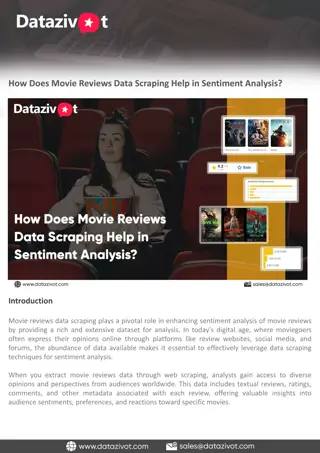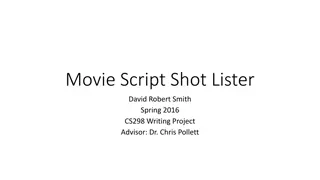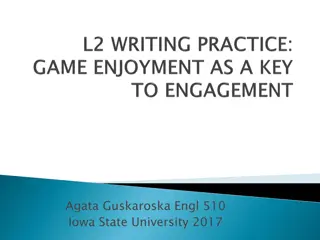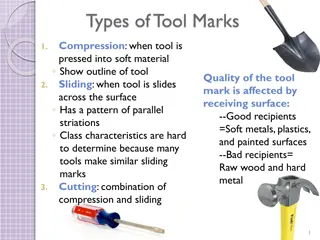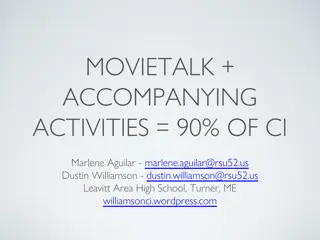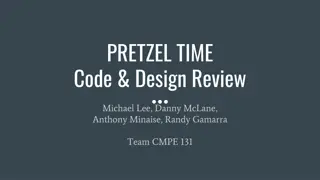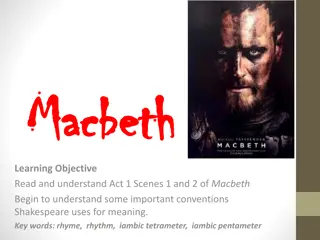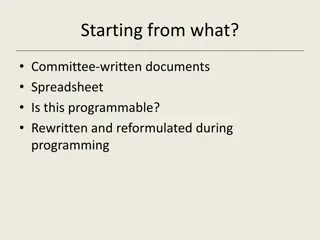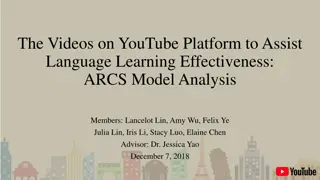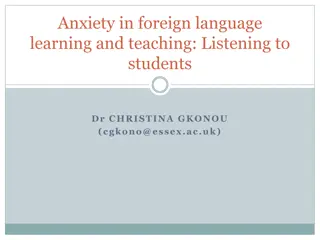Innovative Language Learning Tool: Seleaf - Utilizing Movie Scenes for Education
Seleaf is a cloud-based search engine using a tagged corpus of spoken English from movies to aid language learning. It offers features like synchronized text, speech, and visual data search, lemmatization, and error behavior analysis. The academic and educational use of Seleaf includes linguistic data breakdown by movies, showcasing how words are used in conversational settings, improving word recognition, and speech rhythm training through movie scenes. The tool also includes a drill section for shadowing practice.
Download Presentation

Please find below an Image/Link to download the presentation.
The content on the website is provided AS IS for your information and personal use only. It may not be sold, licensed, or shared on other websites without obtaining consent from the author.If you encounter any issues during the download, it is possible that the publisher has removed the file from their server.
You are allowed to download the files provided on this website for personal or commercial use, subject to the condition that they are used lawfully. All files are the property of their respective owners.
The content on the website is provided AS IS for your information and personal use only. It may not be sold, licensed, or shared on other websites without obtaining consent from the author.
E N D
Presentation Transcript
Movie scene corpus for Movie scene corpus for language learning language learning Eiichi Yubune (Toyo University), Ryuji Tabuchi (Mint Applications), Akinobu Kanda (Tokyo Metropolitan University), Takane Yamaguchi (Waseda University)
1. 1. Seleaf Seleaf: Features : Features and and Specifications Specifications http://www.mintap.com http://www.mintap.com - Is a cloud-based search engine for a tagged corpus of spoken English along with its video pictures from movies. - stores 20 hours of 20 premier movies, which are broken down into 30,000 scenes, 20,000 phrases, and 130,000 words. - enables you to search movie scenes by its script: text data are stored in such a way as to be synchronized with their speech data and visual information. - English transcription and the Japanese subtitles can be switched on an off. - Each word is lemmatized: e.g. the search word go leads you to go, went, gone, goes and going
2. Academic Use of 2. Academic Use of Seleaf Seleaf - spoken English based on 20 movies from the both continents. - Approximately 20,000 phrases phrase were cut out by pause- detecting program using the default value 100 msec. - the average number of words per phrase is 6.1 words and the average duration is 1.92 seconds: - almost parallel to the reported time constraints for language processing such as the working memory and its supposed phonological loop (Baddeley, 1992; 2000). - The Drill section provides valuable data about the learners error behaviour.
Table 1. Linguistic Data broken down by movies N of phrases Average number of words per phrase Average duration in msec. Movie Title Gone with the Wind 3,943 6.6 1,958 1 Citizen Kane 2,084 6.1 1,940 2 Roman Holiday 1,494 5 1,789 3 Rebecca 2,264 7 1,901 4 Lassie 1,061 5.6 1,803 5 Sharade 1,719 6.2 1,961 6 King Kong 1,043 6 1,724 7 Carmen 1,045 6.8 2,033 8 Casablanca 2,130 6 1,685 9 The Wizard of Oz 1,668 5.9 2,212 10 Arabian Nights 1,100 5.9 2,112 11
3. Educational Educational Use of Use of Seleaf Seleaf - To present movie scenes to show how a particular word or phrase is used in conversational settings. - To demonstrate examples of how phonetic features of English are realized (along with the speakers mouth movement and facial expressions). To help learners improve word recognition and speech rhythm. - Seleaf as a motion picture dictionary for individual learners. - languge usage and pragmatic use - bookmark function
4. Educational Use: Educational Use: Seleaf Seleaf Drill Drill - Shadowing section helps learners to read aloud or shadow-read any phrases repeatedly.
4. Educational use: Listening & Dictation section Listening & Dictation section
Data from the Drill section level drill method input device number duration words WPS words arrangement mouse 70 1.4 3.9 2.8 B1 words arrangement mouse 70 1.8 5.2 2.8 B2 words arrangement mouse 70 2.2 7.0 3.1 B3 first letter dictation keyboard 63 1.7 6.0 3.5 C1 first letter dictation keyboard 65 2.2 8.2 3.8 C2 mean 1.9 sec. 6.1 3.2
Error logs from the Drill section No. 1 2 3 4 5 6 7 8 9 No. 1-4 5-6 level B1 B1 B1 B1 C1 C1 C1 C1 C1 level B1 C1 index 230 230 230 230 213 213 213 213 213 index 230 213 point 13 4 0 -1 7 2 1 -1 -1 error ans. [1,2,4,3,5] [1,4,3] [1,2,3,4] word 1 I I'll error trace ["","","[5]","",""] ["","","","","L",""] ["","","","LRSXBVMNCZJHK","O","TISDHBCJN"] ["","","EA","MEKSLON","L"] 2 3 4 don't feel any be calm and 5 different. relaxed 6 and
4. Educational use: role role- -playing playing A particular actors voice can be cut off so that students can work on role-playing exercise.
5. Experiment Experiment Purpose: To measure the learning outcome of classroom training through Seleaf. Method: - Second year Japanese college students (n=18) studied by Seleaf for 20 minutes every week for 4 months. - Pre and Post test were carried out using Standardized Test for English Proficiency (STEP) semi-second level listening test (20 short conversations and monologues with multiple choice comprehension questions).
5. Experiment (2) Experiment (2) Results: - The average score increased from 14.5 to 16.3 (t(17)=2.11, p<0.01, d=0.96). 20 19 18 17 16 15 14 13 12 pre test post test
5. Experiment (3) Experiment (3) - The relationships between Pre- and-post test results and study hours were analyzed. - The diameter of a circle represents the total amount of study hours. - A middle level correlation was found between the study hours and test score gains (r= .45).
5. Experiment (5): Experiment (5): questionnaire (2) - 16 Five-point Likert-scale questionnaires at the pre and the post tests. - A significant increase in the questionnaire item I m listening while being aware of the sense group (chunks). (+0.6 up; Z=1.92, p<0.05, r=0.45, Wilcoxon signed rank test). U S A L M S H N B C J A L USA LMS HNBC JAL
5. Experiment (4): Experiment (4): questionnaire - A slight increase in some other questionnaire item (+0.3 up; no statistical significance). Listening is fun. I do not turn back while reading. I do not translate while reading.
6. Conclusion 6. Conclusion - A training method where learners try to connect the sound and written scripts on the basis of breath groups may improve their overall listening comprehension, - as well as increase their motivation of learning English through listening training.
References References Baddeley, A.D. (1992). Working Memory. Science, 255, 5044, 556 559. Baddeley, A.D. (2000). The Episodic Buffer: A New Component of Working Memory? Trends in Cognitive Sciences, 4, 421.




